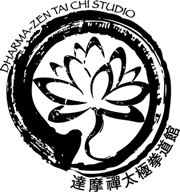Dantian, dan tien or tan t’ien can be is loosely translated as “elixir field.” Chinese: ?? d?ntián ; Japanese: ?? tanden; Korean: ?? danjeon; Thai: ???????? dantian literally “cinnabar or red field”. Your dantien is an important focal point for internal meditative techniques.
There are various points on your body called Dantian. There is one at the top of the skull (top dantian), one at the forehead (upper dantian), one below the heart (middle dantian), one down and beneath the navel (low dantian) and one on the soles of the feet (bottom dantian). However, dantian usually refers to the physical center of gravity located in the abdomen (about three finger widths below and two finger widths behind the navel).
The dantian is important in neidan, qigong, neigong, tao yin and other breathing techniques, as well as in traditional Chinese medicine and meditation. In Eastern martial arts, the navel dantian is particularly important as it becomes the focal point of breathing technique as well as the centre of balance and gravity.
Taoist and Buddhist teachers often instruct their students to center their mind in the dantian. This is believed to aid control of thoughts and emotions. Acting from the dantian is considered to be related to the state of samadhi.
The dantian also roughly corresponds to the Indian concept of the manipura, or navel chakra. In yoga philosophy, it is thought to be the seat of prana that radiates outwards to the entire body. (Source: http://en.wikipedia.org/wiki/Dantian
You can find your low Dantien this way: with your hand flat against your belly, fingers together, thumb above and fingers below, put your thumb directly over your umbilicus. Your hand is over your Dantien. It’s is a larger area that includes both your “Sea of Qi” and the “Hinge at the Source.”
Your “QiHai” or “Sea of Chi” is the point underneath your 2nd finger. It is midway between the navel and Guan Yuan point. It’s the soul of practicing “abdominal breathing.”
It is midway between the navel and Guan Yuan point. It’s the soul of practicing “abdominal breathing.”
The “Hinge at the Source” or “Guan Yuan,” is directly beneath your ring finger (4th finger). It is a reservoir of “qi” and a vital area for practicing and cultivating.
Now that you know something about the importance of your low Dantien, and where it is, let’s massage it. Choose a time when your stomach is empty, like before a meal. This exercise is most effective when you do it every day. Do not do this when you are pregnant.
First briskly rub both hands together until warm.
Then place your right hand on your Dantien, then your left hand on top of your right. Rub your Dantien in small clockwise circles 200-300 times. Don’t rub your belly button.
Now stop and briskly rub your hands together to warm them up again. Place your left hand over your Dantien and your right hand over top. Rub your dantien counterclockwise 200-300 times.
Actions & Effects (As per http://www.yinyanghouse.com/acupuncturepoints/cv4)
? Generally, useful for deficiencies of Yin, Yang, Qi & Blood.
? Main point for tonifying Qi – exhaustion, weakness, chronic fatigue/diseases.
? Main point for Kidney deficiencies of Qi, Jing a/or Yang – low back pain, bone disorders, early morning (5 a.m., “cock-crow”) diarrhea.
? Genito-urinary issues with Deficient a/or Cold Patterns – incontinence, clear copious urine, nocturia.
? Main point for all menstrual disorders with Deficient, Cold a/or Stagnation Patterns – scanty menstruation, pale blood.
? Yang collapse – chills, profuse sweating, SOB, unconsciousness.
? Tong Ren/Tam Healing System: An important point for the storage and development of Qi (energy), useful for deficiency conditions – weakness, shortness of breath, sexual issues.
The high quality Chinese Herbal Patchs/ Chinese Herbal Sprays/ Ointments are available at the Dharmazen online store: http://www.damazen.com/cargo/index.html
